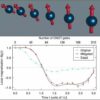A research collaboration led by a Missouri University of Science and Technology physicist has used a new computational process that increases the speed and scale of numerical simulations to observe a previously theorized emerging behavior of light. Despite over 40 years of research, it had remained unknown whether the phenomenon called Anderson localization could take place for the electromagnetic waves.
Anderson localization of light is the absence of electromagnetic waves spreading through a system of randomly placed scattering particles. The complexity of wave interference has made it difficult for researchers to prove that the phenomenon can occur. The research team’s findings, titled “Anderson localization of electromagnetic waves in three dimensions,” published in Nature Physics, proves its existence.
“The situation is similar to why it is extremely difficult to predict a response of human society based on the behaviors of the individual people,” says lead researcher Dr. Alexey Yamilov, professor of physics at Missouri S&T. “It is quite tempting to make assumptions to simplify the problem; however, all previous attempts to observe or rule out Anderson localization of the electromagnetic waves have been in vain.”
Throughout the research, the team worked with startup company Flexcompute, Inc. to use new computing technologies to simulate scattering systems large enough to prove the existence of localization of the electromagnetic waves.
“Using the analogy with a society, we were able, for the first time, to obtain a large enough sample size to conclusively observe an emerging behavior of the group,” says Yamilov.
As a result of this research, future research to observe the localization phenomenon will use metallic systems.
“Incidentally, metallic materials have not been considered viable for about 25 years,” says Yamilov. “Such experiments are the next step to use energy confinement in all three dimensions to enhance optical nonlinearities and light-matter lasing as well as targeted energy deposition interactions, and non-conventional lasers and targeted energy deposition.”
The research group’s large-scale microscopic simulations of electromagnetic wave propagation in 3D is the first reported evidence of wave localization in random groups of metallic particles at a large scale.
More information:
Alexey Yamilov et al, Anderson localization of electromagnetic waves in three dimensions, Nature Physics (2023). DOI: 10.1038/s41567-023-02091-7
Provided by
Missouri University of Science and Technology
Citation:
Team finds new behavior of light: Anderson localization of electromagnetic waves in three dimensions (2023, June 16)



